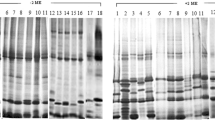Abstract
Comparative investigations of serological characters of seed proteins from taxa regarded as members of theSaxifragales result in the recognition of two distinct groups of related families. One consists of theSaxifragaceae, Grossulariaceae, andCrassulaceae; to itHamamelis, and possiblyPenthorum and theRosaceae may be connected. The second group contains theHydrangeaceae, Escalloniaceae, Roridulaceae, Cornaceae, andCaprifoliaceae; it is rich in iridoid compounds, has more derived morphological characters, and seems to represent a monophyletic line block. ThePittosporaceae were not found to be linked with either of the two groups, but rather show similarities with members of theApiales. All these data support systematic arrangements proposed byDahlgren (1975a).
Similar content being viewed by others
References
Brunner, F., Fairbrothers, D. E., 1978: A comparative serological investigation within theCornales. — Bull. Serol. Mus.53, 2–5.
Büttner, C., 1979: Isolierung der Hauptreserveproteine aus Samen vonAquilegia vulgaris undDigitalis purpurea; Vergleich ihrer serologischen Determinanten mit denen anderer Angiospermen. — Unveröff. Staats-examensarbeit, Universität Köln.
Cronquist, A., 1968: The evolution and classification of flowering plants. — Boston: Houghton Mifflin Co.
Cronquist, A., 1979: How to know the seed plants. — Dubuque, Iowa: Brown Co. Pub.
Dahlgren, R., 1975a: A system of classification of the angiosperms to be used to demonstrate the distribution of characters. — Bot. Not.128, 119–147
Dahlgren, R., 1975b: The distribution of characters within an angiosperm system. I. Some embryological characters. — Bot. Not.128, 181–197.
Ehrendorfer, F., 1978: InStrasburgers Lehrbuch der Botanik, 31. Aufl. — Stuttgart, New York: G. Fischer.
Fairbrothers, D. E., 1977: Perspectives in plant serotaxonomy. — Ann. Missouri Bot. Gard.64, 147–160.
Fairbrothers, D. E., Mabry, T. J., Scogin, R. L., Turner, B. L., 1975: The basis of angiosperm phylogeny: chemotaxonomy. — Ann. Missouri Bot. Gard.62, 765–800.
Ferguson, I. K., 1966: Notes on the nomenclature ofCornus. — J. Arnold Arbor.44, 100–105.
Frohne, D., Jensen, U., 1973: Systematik des Pflanzenreichs, 1. Aufl. — Stuttgart, New York: G. Fischer.
Grund, C., 1979: Die verwandtschaftlichen Beziehungen derSaxifragales unter besonderer Berücksichtigung serologischer Merkmale. — Unveröff. Staats-examensarbeit, Universität Köln.
Hardev, V., 1972: Systematic embryology ofRoridula gorgonias Planch. — Beitr. Biol. Pfl.48, 339–351.
Hillebrand, G. R., Fairbrothers, D. E., 1970: Phytoserological systematic survey of theCaprifoliaceae. — Brittonia22, 125–133.
Huber, H., 1963: Die Verwandtschaftsverhältnisse derRosifloren. — Mitt. Bot. Staatssamml. München5, 1–48.
Hutchinson, J., 1973: The Families of Flowering plants. — Oxford: Oxford Press.
Jensen, S. R., Nielsen, B. J., Dahlgren, R., 1975a: Iridoid compounds, their occurrence and systematic importance in the angiosperms. — Bot. Not.128, 148–180.
Jensen, S. R., Kjaer, A., Nielsen, B. J., 1975b: The genusCornus: nonflavonoid glucosides as taxonomic markers. — Biochem. Syst. Ecol.3, 75–78.
Krach.J. E., 1977: Seed characters in and affinities among theSaxifragineae. — Pl. Syst. Evol., Suppl.1, 141–153.
Lee, Y. S., Fairbrothers, D. E., 1978: Serological approaches to the systematics of theRubiaceae and related families. — Taxon27, 159–185.
Melchior, A., (Ed.), 1964:A. Engler's Syllabus der Pflanzenfamilien2. 12. Ed. — Berlin-Nikolassee: Gebrüder Borntraeger.
Plouvier, V., 1964: Chimie Végétale. Sur la presence de loganoside dans les écorces de quelquesLonicera (Caprifoliaceae) etHydrangea (Saxifragaceae). — Compt. Rend. Acad. Sc. Paris258, 3919.
Rodriguez, R. L., 1971: The relationships of theUmbellales. InHeywood, V. H., (Ed.): The Biology and Chemistry of theUmbelliferae, 63–91. — London: Academic Press.
Schoennagel, E., 1931: Chromosomenzahl und Phylogenie der Saxifragaceen. — Bot. Jahrb.64, 266–288.
Takhtajan, A., 1973: Evolution und Ausbreitung der Blütenpflanzen. — Stuttgart: G. Fischer.
Thorne, R. F., 1976: A phylogenetic classification of theAngiospermae. InHecht, M. C., Steere, W. C., Wallace, B., (Eds.): Evolutionary Biology9, 35–106. — New York: Plenum Press.
Wettstein, R., 1935: Handbuch der systematischen Botanik. — Leipzig, Wien: F. Deuticke.
Author information
Authors and Affiliations
Rights and permissions
About this article
Cite this article
Grund, C., Jensen, U. Systematic relationships of theSaxifragales revealed by serological characteristics of seed proteins. Pl Syst Evol 137, 1–22 (1981). https://doi.org/10.1007/BF00983200
Received:
Issue Date:
DOI: https://doi.org/10.1007/BF00983200




